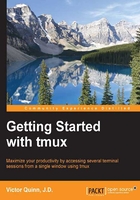
Preface
tmux is rapidly becoming the de facto standard with regards to terminal multiplexers with its breadth of features and ease of configuration. It is one of the fastest growing tools in the developer's toolkit due to its power in maximizing the productivity of a terminal window. Developers spending a large amount of time in the terminal will benefit greatly from learning how to utilize tmux and its powerful features. By taking a single terminal window and turning it into multiple windows, each with their own state, tmux is like a supercharger for your console.
We will begin with a simple introduction to tmux and learn some ways in which it can help increase productivity in your daily terminal usage. From there, we'll move on to configuring and customizing tmux to make it work, look, and feel the way that best suits your needs. Along the way, we have tutorials and screenshots aplenty so that you can follow along and avoid feeling lost. We'll also explain some of the core concepts of tmux, including the way it uses sessions, windows, and panes in order to divide content and running programs.
After learning some of these beginner topics, we will dive into some advanced tmux concepts. We'll touch on how to perform text manipulation to copy and paste text from one window to another or even to and from a file. We'll learn how to use tmux for fault-tolerant SSH sessions or pair programming, and we will finish by discussing some other open source tools that can be used alongside tmux in order to help make it even more powerful.
tmux is an incredibly capable tool, which has some concepts that can be tricky to grasp. This book will help demystify some of these tricky bits with many explanations and rich examples in a manner that cannot be found in the tmux man page.
By the end of book, you will have a much richer understanding of tmux and its capabilities and all the tools necessary to turbocharge your terminal experience. This book covers the following topics:
Chapter 1, Jump Right In, will have us really hit the ground running, taking us through a typical tmux workflow, explaining everything along the way. This allows us to experience how tmux can be useful and illustrating how it can be integrated into your daily workflow.
Chapter 2, Configuring tmux, will teach us how to change and configure almost anything about tmux's behavior, from the way it looks and feels to the commands it executes on the load. You can even configure every key combination to which tmux responds. In this chapter, we will cover the various ways to configure tmux and customize it for your workflow.
Chapter 3, Sessions, Windows, and Panes, will help us learn all about sessions, windows, and panes. These are the fundamental components that make up the window management feature of tmux and this chapter will help us understand what they are and how they relate. We will learn, through example, many ways we can work with them in order to turbocharge our terminal with tmux.
Chapter 4, Manipulating Text, helps us learn about the powerful tools of tmux for text manipulation. These tools take the form of Copy mode and paste buffers, and we will learn more about them and how to use them for very powerful text manipulation with features such as scrolling through text that has scrolled off screen and copying text from anywhere in the window history and pasting it, often without ever needing to reach for your mouse.
Chapter 5, Diving Deeper, touches on some more nuanced aspects of topics we have covered already. These topics include tmux commands and its Command mode, advanced paste buffer usage, and some advanced usage of windows and panes. We'll finish it off with learning how to launch a tmux session with some default windows.
Chapter 6, tmux for SSH, Pair Programming, and More, will walk us through a couple of usage patterns that can prove to be powerful. It will help us learn about using tmux over SSH for long-lived sessions for pair programming, and along the way, we will use Vagrant for some predictability and security.
Chapter 7, Using Other Tools with tmux, will allow us to discuss some third-party tools that can run along with tmux and add more powerful features. We'll learn about tmuxinator, which simplifies the tmux launch configuration and wemux, which brings the tmux multiuser experience to a whole new level. We'll learn about these along with a few other tricks and utilities.
Appendix contains three sections, namely Why tmux?, The configuration reference, and Key binding and command reference.